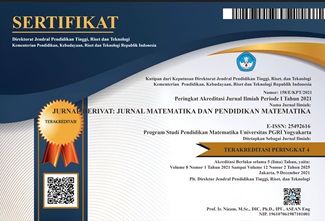Enhancing Mathematical Understanding Through Ethnomathematics: A Study Of The Pusaka Monument's Geometric Structures
DOI:
https://doi.org/10.31316/jderivat.v10i2.6367Abstract
Several previous studies have examined the ethnomathematical exploration of cultural sites. However, there has been no research specifically exploring the Tugu Pusaka. This study explores the ethnomathematics found in the Pusaka Monument in Selogiri, Wonogiri Regency. Ethnomathematics examines how cultural groups understand and use mathematical concepts. The Pusaka Monument, with its geometric structure, offers numerous aspects for study within this context. The objective of this research is to describe the mathematical concepts present in the Pusaka Monument and to integrate these concepts into mathematics education. The research employs a survey method conducted at the Pusaka Monument site, with purposive sampling to ensure relevance and significance. The study follows a series of steps: literature review, field data collection, and descriptive and factual analysis of findings. Data collection involved observation, interviews, and documentation. The data were analyzed qualitatively, focusing on identifying geometric concepts within the monument's structure. This research aims to enhance students' understanding of mathematics through the integration of cultural elements and to promote the preservation of Indonesia's cultural heritage through ethnomathematics. The findings are expected to contribute to the development of a more contextual and culturally-based mathematics curriculum, enriching both mathematical education and cultural awareness among students.
Keywords: Ethnomatematika, Mathematics Education, Pusaka Monument Selogiri, Cultural Heritagez
References
Ascher, M. (1991) Ethnomathematics: A Multicultural View of Mathematical Ideas. New York. Available at: https://doi.org/10.1201/9780203756522.
Febriana, R. et al. (2022) ‘Eksplorasi Etnomatematika Pada Tugu Jogja’, Pedagogy: Jurnal Pendidikan Matematika, 7(1), pp. 39–48. Available at: https://doi.org/10.30605/pedagogy.v7i1.1799.
Gerdes, P. (1994) ‘Reflections on Ethnomathematics.’, For the Learning of Mathematics, 14(2), pp. 19–22.
Irsyad, M., Sujadi, A.A. and Setiana, D.S. (2020) ‘Eksplorasi Etnomatematika pada Candi Asu’, UNION: Jurnal Ilmiah Pendidikan Matematika, 8(1), pp. 11–19. Available at: https://doi.org/10.30738/union.v8i1.7609.
Ishartono, N. and Ningtyas, D.A. (2021) ‘Exploring Mathematical Concepts in Batik Sidoluhur Solo’, International Journal on Emerging Mathematics Education, 5(2), p. 151. Available at: https://doi.org/10.12928/ijeme.v5i2.20660.
Jatia, S.P., Mastur, Z. and Asikin, M. (2019) ‘Potensi Etnomatematika untuk Mengembangkan Kemampuan Komunikasi Matematis’, Prosding Seminar Nasional Matematika dan Pendidikan Matematika, 2, pp. 277–286.
Krathwohl, D.R. and Anderson, L.W. (2010) ‘Merlin C. Wittrock and the revision of bloom’s taxonomy’, Educational Psychologist, 45(1), pp. 64–65. Available at: https://doi.org/10.1080/00461520903433562.
Mufidatunnisa, N. and Hidayati, N. (2022) ‘Eksplorasi Etnomatematika Pada Monumen Dan Museum Peta Di Kota Bogor’, Teorema: Teori dan Riset Matematika, 7(2), p. 311. Available at: https://doi.org/10.25157/teorema.v7i2.7231.
Munthahana, J. and Budiarto, M.T. (2020) ‘Ethnomatematics Exploration in Panataran Tample and Its Implementation in Learning’, Indonesian Journal of Science and Mathematics Education, 3(2), pp. 196–209.
Ni’mah, N.T. and Marlina, R. (2021) ‘Eksplorasi Etnomatematika Pada Monumen Tugu Kebulatan Tekad’, JIPMat, 6(1), pp. 76–84. Available at: https://doi.org/10.26877/jipmat.v6i1.8018.
Prahmana, R.C.I. and D’Ambrosio, U. (2020) ‘Learning geometry and values from patterns: Ethnomathematics on the batik patterns of yogyakarta, indonesia’, Journal on Mathematics Education, 11(3), pp. 439–456. Available at: https://doi.org/10.22342/jme.11.3.12949.439-456.
Rahman, S.A. et al. (2022) ‘Etnomatematika : Eksplorasi Konsep Geometri’, Journal Of Authentic Research on Mathematics Education (JARME), 4(2), pp. 217–233.
Revanny, I., Fauziyah, N. and Mariana, N. (2022) ‘Eksplorasi Etnomatematika Konsep Bangun Datar Pada Cagar Budaya Balai Pemuda Surabaya’, Jpgsd, 11(09), pp. 2019–2031.
Sartika, B. et al. (2023) ‘Eksplorasi Etnomatematika Pada Artefak Peninggalan Sejarah Di Kota Ntt’, Jurnal Ilmiah Matematika Realistik (JI-MR, 4(1), p. 79.
Setiana, D.S. et al. (2021) ‘Eksplorasi etnomatematika Museum Kereta Kraton Yogyakarta dan pengintegrasiannya ke dalam pembelajaran matematika’, Ethnomathematics Journal, 2(1), pp. 1–10. Available at: https://doi.org/10.21831/ej.v2i1.36210.
Solopos Soloraya (2017). Available at: https://soloraya.solopos.com/asal-usul-tugu-pusaka-selogiri-tempat-menyimpan-keris-dan-tombak-pangeran-samber-nyawa-851997.
Sulistyowati, D. and Khotimah, R.P. (2022) ‘An Exploration of Ethnomathematics at Sewu Temple in Yogyakarta’, Jurnal Riset Pendidikan Matematika, 9(2), pp. 177–190.
Wonogiri TIC (2024). Available at: https://tic.wonogirikab.go.id/web/places/detail/73.
Zaenuri and Dwidayati, N. (2018) ‘Menggali Etnomatematika: Matematika sebagai Produk Budaya’, PRISMA, Prosiding Seminar Nasional Matematika, 1(1), pp. 471–476.
Zayyadi, M. (2017) ‘Eksplorasi Etnomatematika Pada Batik Madura’, SIGMA: Kajian Ilmu Pendidikan Matematika, 2(2), pp. 35–40.
Downloads
Published
Issue
Section
Citation Check
License
Copyright (c) 2024 Atikah Mufidah

This work is licensed under a Creative Commons Attribution-ShareAlike 4.0 International License.
Authors who publish with this journal agree to the following terms:
-
Authors retain copyright and grant the journal right of first publication with the work simultaneously licensed under a Creative Commons Attribution-ShareAlike 4.0 International License that allows others to share the work with an acknowledgment of the work's authorship and initial publication in this journal.
- Authors are able to enter into separate, additional contractual arrangements for the non-exclusive distribution of the journal's published version of the work (e.g., post it to an institutional repository or publish it in a book), with an acknowledgment of its initial publication in this journal.
- Authors are permitted and encouraged to post their work online (e.g., in institutional repositories or on their website) prior to and during the submission process, as it can lead to productive exchanges, as well as earlier and greater citation of published work (See The Effect of Open Access).







